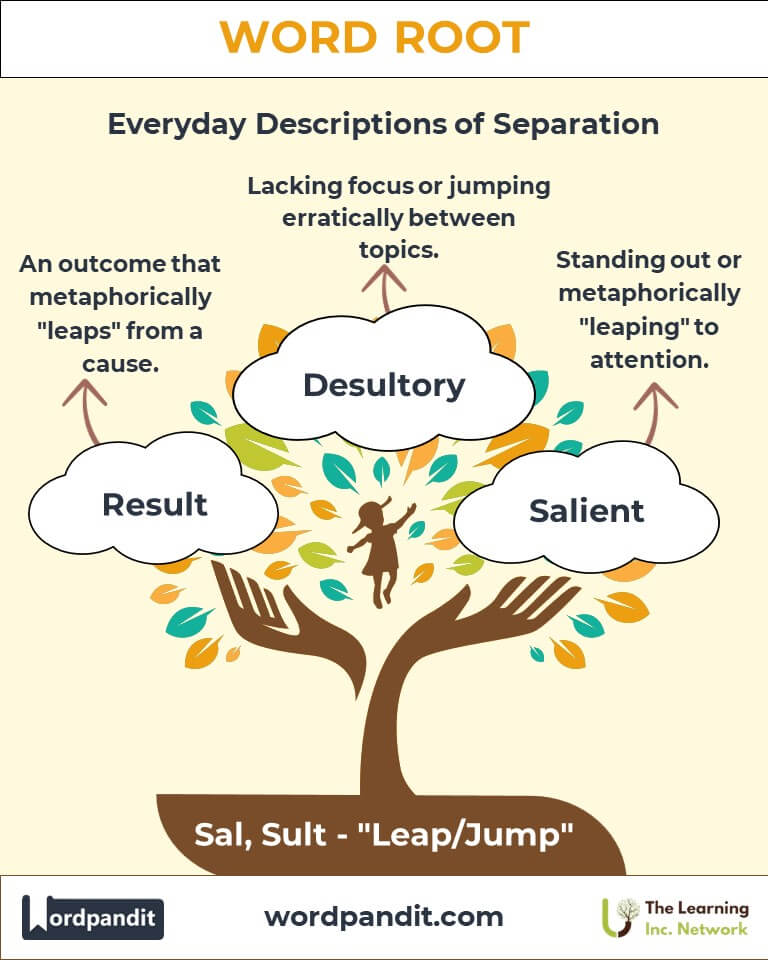Sal, Sult: The Leap of Language and Motion
Byline: Discover the dynamic power of the roots "sal" and "sult," originating from Latin and meaning "leap" or "jump." These roots infuse energy into our vocabulary, appearing in terms from "somersault" to "result." Explore their fascinating journey through language, their impact across fields, and their ability to convey motion, transformation, and change.
Table of Contents
- Introduction: The Energy of Sal and Sult
- Etymology and Historical Journey
- Mnemonic: Remembering Sal and Sult
- Common Sal and Sult Words
- Sal and Sult Through Time
- Sal and Sult in Specialized Fields
- Illustrative Story: Sal and Sult in Action
- Cultural Significance of Sal and Sult
- The Sal and Sult Family Tree
- FAQs About the Sal and Sult Word Root
- Test Your Knowledge: Sal and Sult Word Root Quiz
- Conclusion: The Vibrant Legacy of Sal and Sult
1. Introduction: The Energy of Sal and Sult
What comes to mind when you think of a somersault? Likely, it’s a graceful leap, a burst of energy encapsulated in motion. The roots sal (pronounced "sal") and sult (pronounced "sult") carry this vibrant meaning of "leap" or "jump." Derived from Latin, these roots add dynamism to our language, expressing movement, transformation, and outcomes across various contexts.

2. Etymology and Historical Journey
The roots sal and sult stem from the Latin verb salire, meaning "to leap" or "to jump." In ancient times, these roots described both physical movements—like leaping across a stream—and metaphorical actions, such as sudden changes or emotional surges.
As Latin evolved into Romance languages and later influenced English, these roots appeared in words like:
- Somersault: To perform a full-body leap or flip.
- Result: An outcome or effect, metaphorically leaping from a cause.
The transformation of salire reflects the linguistic leap from literal motion to conceptual shifts in meaning.
3. Mnemonic: Remembering Sal and Sult
Picture a lively frog on a springboard, ready to leap into a shimmering pond. As it jumps, imagine the words "sal" and "sult" etched in the ripples of the water. This mental image ties the roots to their core meaning of motion and outcomes.
Mnemonic Device: “Sal and Sult spring into action—leaping into language with energy and change!”
4. Common Sal and Sult Words
- Somersault (su-mer-sawlt): A complete flip, typically in gymnastics or acrobatics.
Example: "The gymnast executed a flawless somersault during her routine." - Result (ri-zuhlt): The outcome or consequence of an action or event.
Example: "The experiment’s result confirmed the hypothesis." - Exult (ig-zuhlt): To leap for joy; to feel or express great happiness.
Example: "She exulted in her team’s victory." - Salient (say-lee-uhnt): Standing out or leaping to the forefront; prominent.
Example: "The most salient point in the debate was the need for sustainability." - Desultory (deh-sul-tor-ee): Lacking a clear plan or jumping from one topic to another.
Example: "His desultory conversation made it hard to follow his thoughts."
5. Sal and Sult Through Time
- Salient (16th Century):
- Origin: From Latin salire, meaning "to leap."
- Evolution: Shifted from describing leaping physical features to metaphorically highlighting importance.
- Desultory (17th Century):
- Origin: From Latin desultor, a circus performer who leaped between horses.
- Evolution: Expanded to describe erratic or aimless actions in modern English.
6. Sal and Sult in Specialized Fields
- Medicine: Salient Reflex: A sudden jerking movement in response to stimuli.
Application: Studied in neurology to diagnose conditions affecting motor responses. - Architecture: Salient Feature: A prominent or projecting part of a structure.
Example: Used in describing fortifications or distinctive design elements. - Psychology: Exultation: The leap of joy often linked to positive reinforcement.
Application: Explored in studies of emotional responses and behavior. - Literature: Desultory Style: Writing that jumps erratically between topics.
Example: Found in stream-of-consciousness narratives.
7. Illustrative Story: Sal and Sult in Action
In a bustling city, a young inventor named Leo worked tirelessly on a project. After months of trials, he finally achieved a breakthrough. The moment the machine whirred to life, Leo felt an overwhelming urge to exult. His invention—a robot capable of performing somersaults—was inspired by his childhood love of acrobatics. This salient achievement not only transformed his career but also symbolized his leap of faith into innovation.
8. Cultural Significance of Sal and Sult
The roots sal and sult have left their mark on culture, from ancient Roman festivals featuring leaping dancers to modern language capturing emotional highs and dramatic outcomes. In literature, salient characters leap off the page, and in psychology, exultation embodies human joy.

9. The Sal and Sult Family Tree
- Salt- (Latin: "jump"):
- Saltation: The act of leaping or jumping.
Example: Describes sudden changes in biological evolution.
- Saltation: The act of leaping or jumping.
- Sur- (Latin prefix: "over"):
- Surpass: To leap over or exceed expectations.
- -Ery (Suffix: action/state):
- Desultory: A state of jumping between topics.

10. FAQs About " Sal" and "sult "
Q: What do the roots "sal" and "sult" mean?
A: The roots "sal" and "sult" come from the Latin verb salire, meaning "to leap" or "to jump." These roots convey a sense of movement, energy, or transition, both in a physical and metaphorical sense. For example, a "somersault" involves an actual physical leap, while a "result" refers to the figurative leap or outcome of an action.
Q: What is the origin of "somersault"?
A: "Somersault" comes from the Old French word sombresault, which combines sobre (over) and saut (jump). It entered English to describe a flip or leap, typically involving turning the body over completely.
Q: Why does "result" include the root "sult"?
A: The word "result" is derived from the Latin resultare, meaning "to spring back." Metaphorically, it refers to an outcome that "leaps back" or follows from a preceding action, much like a cause leads to an effect.
Q: What does "salient" mean, and how does it relate to "leap"?
A: "Salient" means "prominent" or "standing out." The connection to "leap" lies in the imagery of something leaping forward or outward, drawing attention. Originally used to describe leaping animals or projections, it now applies metaphorically to noticeable or important features.
Q: What is the meaning of "saltation"?
A: "Saltation" is a term used in biology, geology, and other sciences to describe sudden leaps or changes. For instance, in evolution, saltation refers to abrupt changes in traits rather than gradual transitions.
Q: What does "exult" mean, and why is it associated with joy?
A: "Exult" means to leap with joy or express great happiness. It derives from Latin exsultare, where ex- means "out" and sultare means "to leap." Together, it conveys the idea of bursting or leaping outward with emotion.
Q: Why is "desultory" used to describe aimlessness?
A: "Desultory" comes from Latin desultor, meaning "a circus rider who jumps from horse to horse." Over time, the word evolved to describe actions or thoughts that lack focus or move erratically from one topic to another.
11. Test Your Knowledge: Sal" and "sult Mastery Quiz
1. What do the roots "sal" and "sult" signify?
2. Which word describes a joyful leap?
3. What does "salient" mean?
4. What is the origin of "desultory"?
5. What does "somersault" describe?
12. Conclusion: The Vibrant Legacy of Sal and Sult
The roots sal and sult encapsulate the energy of motion and transformation. From physical leaps like somersaults to metaphorical jumps like results, these roots continue to shape our language, inspiring expressions of dynamism and change. Embrace the leap and explore how these roots enrich our world of words!












